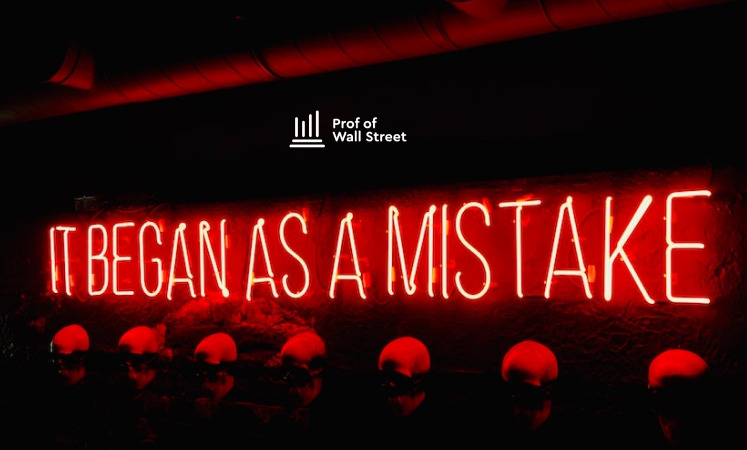They say comedy is tragedy plus time, but it’s been a while since I missed out on a quarter million dollars. And it’s still not funny. But you might just learn something from this painful story of mine which ultimately led me to start Prof of Wall Street.
What Happened?
As a PhD student, I was slated to teach behavioral finance at the Claremont Colleges in the fall. I assumed that my discerning undergrads at Claremont would share the same feeling I had about professors: That they better bring some good ‘war stories’ to go along with whatever they were teaching!
But what practical advice could I infuse into my lectures? I decided to take out $10,000 in unneeded student loans to invest all of it in the stock market. As I got ready to apply all I had learned in my quantitative and behavioral finance courses, I anticipated making small mistakes that would serve as my future lecture anecdotes. What a great plan I had.
I started my investing journey by opening a retail investing account with the lowest per-trade fees I could find, a platform that was later acquired by E-Trade. I was a novice at portfolio construction and had yet to take a portfolio management class. So I was unaware of mean-variance optimization, value at risk, or the efficiency of ETFs relative to stock picking.
One of my first buys were shares of a rapidly growing chipmaker called Nvidia (NASDAQ: NVDA) at about $7 per share, shares of Apple since iPhone sales were exploding (NASDAQ: AAPL) at around $20, Ford (NYSE: F) because it did well during the financial crisis, and First Solar (NASDAQ: FSLR) because it was recommended in an investment newsletter written by my high school math teacher. I naively allocated my borrowed money across these stocks without much consideration of the risks or relative value of the stocks.
Not long after buying these stocks, Nvidia shot up to $20 and, as excited as could be, I sold hundreds of shares of it, pocketing a 185% gain. I remember thinking “This is so easy!” and wondering what the big hoopla around investing was about. I kept some Nvidia shares in the portfolio in case I was wrong, and carried on buying and selling shares, making and losing money intermittently.
Fast forward to 2021 when NVIDIA peaked at over $1,300 per share, meaning that the hundreds of shares I had sold for a pittance around 2011 would be worth about $250,000.
Let that sink in.
$250,000.
That down payment for a new home? Yup, gone. Paying off student loans much faster? Blew that opportunity, too.
Why Did This Happen?
You see, I jumped at the opportunity to lock in gains far too early. I didn’t yet understand my own knee-jerk, risk averse response and I allowed my own impulsivity to dictate the decision to sell a winning position. This decision was motivated by behavioral factors and not informed by the (in retrospect) obvious economic fundamentals that pointed towards “hold” or “buy” ratings that I should have followed instead.
The key here is that risk aversion, i.e., what economists call the preference for safe rather than risky assets, led me astray as I was unable to disentangle my own feelings from the facts at the time.
Most people cannot tell the difference between an internally generated impulse and an externally objective fact, which is why most people react to personal investment losses and gains from the reference point of their Average Cost Basis (ACB) instead of the broader data. This may not seem problematic, and you might think that people should be concerned with how well their accounts are doing. I agree that profits and losses need to be carefully managed, but my key message to you here is that the market doesn’t care what your particular ACB is. It might continue pushing the price far above a level you’re subjectively comfortable with holding onto and not selling.
Everybody Has a Story
I’m not special. And neither is my story. This is why risk aversion is considered the most common economic “primitive” factor among people. If you talk to enough people about investing, you will quickly learn that just about every investor has at least one story about selling something too soon that went to the moon later on.
Short-sighted profit taking kill the big gains
Someone recently confided in me to selling hundreds of bitcoins at $10, missing out on over $30 million in profits. Sure, I feel better after hearing other people’s mistakes, but the bad news is that nothing can turn back the hands of time and bring me back to the moment of making that fateful, life-changing mistake of selling my Nvidia stock.
There are consequences for the market itself, as behavioral mistakes widen the spread between a stock’s fundamental value and its equilibrium price and induce price underreaction to new information.
This behavior is not limited to equities, researchers find evidence of behavioral errors across many asset classes, including real estate (Crane 2010), mutual funds (Cici 2010), derivatives (Chen 2007), mergers and acquisitions (Pengfei, 2014), cryptocurrencies (Haryanto et al. 2019), FOREX (Heiden & Moritz, 2019), and likely other alternative assets such as art and cars.
The president of a large investment company sold her house in Toronto to profit from the bull market that materialized since she had bought the home. When we discussed it, she realized that she had failed to consider that the market was predicted to continue rising rapidly, causing her to miss out on the opportunity to sell for much, much more in the near future. I asked if she needed the money to buy her next home and she said she did not; she just wanted to lock in the gains. Sounds like typical risk aversion to me.
There is fascinating work on the neuroscience of decision-making that helps us understand why this occurs. This field is known as “neuroeconomics.” The reason why we see similar decisions being made across various scenarios and asset classes is because of the high likelihood that the brain encodes value in a universal fashion and therefore consistently pushes us to act in a risk averse manner regardless of the specific “good” in question.
Knowing this, I began to think about how I can design a decision process that harnesses neuroscience to help us make better decisions and avoid common and costly pitfalls.
Turning Lemons into Lemonade
Looking back, making mistakes just to have a good story to tell was definitely not worth it. I’d rather have the money I left on the table. But here’s the real question we need to ask: Have I made similar mistakes since? I’m proud to say that I have not, and that there are a number of assets in my portfolio that have increased significantly due to me developing the capacity to resist the urge to sell simply due to risk aversion.
But I don’t regret my mistake because I’ve learned from it, seldomly repeat it, and have made it my mission to spare others the same misfortune.
The good news is that we don’t need to time travel to live a better life, since every day presents new opportunities to make better decisions.
Before I sell a position, I think back to this mistake and walk through a series of questions designed to “catch” any cognitive mistakes and help me parse through my own logic. In fact, my team and I have encoded evidence-based decision making processes into the Prof of Wall Street SmartTrade platform to help us (and you) make better decisions without having to learn everything the hard way (read: miss out on eye-watering sums of money).
This specific decision pattern is quantified in our proprietary quantitative service for both professional and retail investors and can help you see whether you have a consistent pattern of selling winners too soon (and/or losers too late, but let’s save that topic for another article).
If my story could teach you anything, it is that historical data matters. If you’d like to have your historical data analyzed to better understand your own investing patterns, reach out to me and my team and I will create a personalized analysis for you to maximize your investing upside.
Invest Wisely,

Quiz:
1. What is the behavioral bias that led to the selling of Nvidia (NASDAQ: NVDA) at $16?
A. Exponential growth bias
B. Risk aversion
C. Loss chasing
D. Representativeness
2. Is risk aversion confined to equities only?
A. Yes
B. No
C. Only international equities
D. Only US-based equities
3. What can I do to reduce the probability of making impulsive decisions that lead to bad investing outcomes?
A. Speed up the decision making process
B. Slow down the decision making process
C. Let someone else decide for me
D. Change nothing
4. How are financial markets affected when many investors sell shares to make a profit?
A. Prices become more volatile due to selling pressure
B. Prices become more stable
C. Prices do not rise as much as anticipated by momentum
D. Both a and c
Answer key: 1:b, 2:b, 3:b, 4:d
